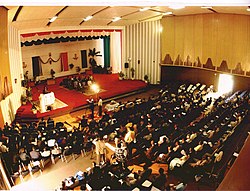Here in this post, we discussed the lower chamber of parliament of Burundi which is the National assembly and also the history of the Assembly.
The National Assembly is the lower chamber of Parliament in Burundi. It consists of 100 directly elected members (or deputies) and between 18 and 23 co-opted members who serve five-year terms.

Deputies are elected in 17 multi-member constituencies using a party-list proportional representation system in accordance with the D’Hondt method. Political parties and lists of independent candidates must receive over 2% of the vote nationally to gain representation in the National Assembly.
HISTORY
As a country that has been devastated by civil war and persistent ethnic violence since its independence in 1962, Burundi’s new constitution (approved in a February 2005 referendum) requires that 60% of the deputies be from the Hutu ethnic group, while the remaining 40% come from the Tutsi ethnic group. In addition, three co-opted members represent the Twa ethnic group. Women must occupy at least 30% of the seats in the National Assembly.
Read: SENATE OF BURUNDI
Elections to the National Assembly took place on 4 July 2005. The National Council for the Defense of Democracy-Forces for the Defense of Democracy (CNDD-FDD) won 59 of the 100 seats filled through direct election. The Front for Democracy in Burundi (FRODEBU), who won a majority of seats in the previous election held in 1993, won 25 seats. The Union for National Progress (UPRONA) won 10, while the National Council for the Defense of Democracy (CNDD), a breakaway faction of the CNDD-FDD, won 4. The small, predominantly Tutsi Movement for the Rehabilitation of Citizens-Rurenzangemero (MRC-Rurenzangemero), won the remaining 2 seats. An additional 18 members were co-opted to meet the required ethnic and gender quotas.
Immaculée Nahayo, an ethnic Hutu member of the CNDD-FDD, was elected president of the National Assembly on 16 August 2005.
On 19 August 2005, the National Assembly and Senate Assembly (acting as an Electoral College) elected Pierre Nkurunziza president of the republic. He took office on 26 August 2005.
LIST OF PRESIDENTS OF THE NATIONAL ASSEMBLY OF BURUNDI
The president is the presiding officer in the National Assembly of Burundi.
| Name | Took office | Left office |
| Thaddée Siryuyumunsi | 28 September 1961 | 1962 |
This is a list of presidents (speakers) of the National Assembly of Burundi:
| Name | Took office | Left office |
| Thaddée Siryuyumunsi | July 1, 1962 | 1965 |
| Emile Bucumi | 1965 | 1965 |
| No Legislative Arm of Government | 1965 | 1982 |
| Emile Mworoha | 1982 | 3 September 1987 |
| No Legislative Arm of Government | 1987 | 1993 |
| Pontien Karibwami | July 1993 | 21 October 1993 |
| Sylvestre Ntibantunganya | 23 December 1993 | 1 October 1994 |
| Jean Minani | 1 December 1994 | January 1995 |
| Léonce Ngendakumana | 12 January 1995 | 25 July 1996 |
| No Legislative Arm of Government | 1996 | 1998 |
| Léonce Ngendakumana | 18 July 1998 | 2002 |
| Jean Minani | 10 January 2002 | August 2005 |
| Immaculée Nahayo | 16 August 2005 | 16 March 2007 |
| Pie Ntavyohanyuma | 16 March 2007 | June 2015 |
| Pascal Nyabenda | 30 July 2015 | 7 August 2020 |
| Gélase Daniel Ndabirabe | 7 August 2020 | Present |


